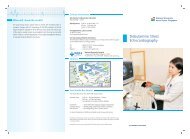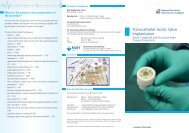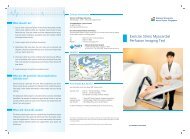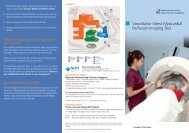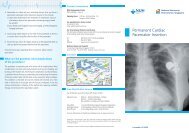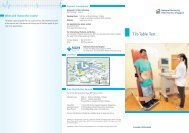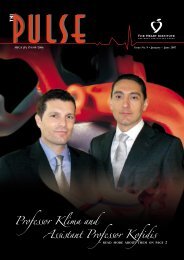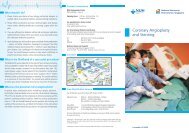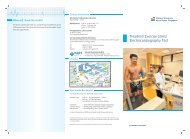Transcatheter Aortic Valve Implantation (TAVI) - nuhcs
Transcatheter Aortic Valve Implantation (TAVI) - nuhcs
Transcatheter Aortic Valve Implantation (TAVI) - nuhcs
Create successful ePaper yourself
Turn your PDF publications into a flip-book with our unique Google optimized e-Paper software.
What are the potential risks/complicationsof the procedure?While <strong>TAVI</strong> is a minimally-invasive procedure, it still carries significant risks.The two most frequent and serious risks are serious damage to the majorblood vessels, and stroke.Below is a summary of associated risks of <strong>TAVI</strong> procedure:• Death (1 – 10%)• Heart or blood vessel injury, such asperforation or damage of bloodvessels, heart muscle valve structuresthat may require emergency surgery(1 – 10%)• Heart attack (1 – 10%)• Stroke (1 – 10%)• Clot (1 – 10%)• Hemorrhage (bleeding) requiringtransfusion (0.1 – 5%)• Hematoma (1 – 10%)• Hypertension (high blood pressure) /Hypotension (low blood pressure)(0.1 – 5%)• Kidney failure needing dialysis(0.1 – 10%)• Kidney dysfunction (0.1 – 25%)• Allergic dye reaction (0.1 – 1%)• Anesthesia reaction (1 – 10%)• Abnormal heart rhythms (0.1 – 25%)• Heart conduction system injury, whichmay require a permanent pacemaker(1 – 10%)• Fever (0.01 – 1%)• Infection including valve infection(0.01 – 1%)• Pericardial effusion / cardiactamponade (bleeding into the heartsac) (0.1 – 1%)• Nerve injury (0.01 – 0.1%)• Arteriovenous (AV) fistula anabnormal passageway between anartery and a vein (0.01 – 0.1%).• Short term use of intra-aortic balloonpump to assist heart function (1%)• Lower limb ischemia / limb loss(0.5%)• Emergency aortic valve surgery byconventional method (1 – 3%)Neverthless, potential risks of valve replacement vary significantly fromperson to person depending on age, overall health, and other factors. Discussthe risks in detail with your doctor before you consent to the procedure. Itis important to note, however, that untreated severe aortic stenosis posesa high risk of progressive symptoms or death.Always inform other doctors about your heart valve replacementbefore any medical or dental procedure. Before undergoing a MRI(magnetic resonance imaging) procedure, always notify the doctoror medical technician that you have an implanted heart valve.Failure to do so may result in damage to the valve that could lead to death.LocationNational University Hospital5 Lower Kent Ridge Road, Singapore 119074Tel: 6779 5555 Fax: 6779 5678 Website: www.nuh.com.sgContact InformationNational University Heart Centre, Singapore1 Main Building. Angiography Centre, Level 2.Opening Hours: 8.30 am - 5.30 pm (Monday - Friday)Closed on Weekend & Public HolidaysWebsite: www.<strong>nuhcs</strong>.com.sgFor appointments, please contact: Tel: (65) 6772 2002 Email: appointment@nuh.com.sgFor International Patients and VisitorsThe International Patients Liaison Centre (IPLC) is a one-stop service centre to support theneeds of our foreign patients and visitors.24-Hour Helpline: (65) 6779 2777Email: iplc@nuhs.edu.sgGetting to NUHCircle Line Kent Ridge MRT StationCommuters can transit at the Buona Vista MRT Interchange and alight two stops after at theKent Ridge Station. The station will be served by two exit-entry points.Exit A: Right at the doorstep of National University Heart Centre, Singapore.Exit B: Along South Buona Vista Road, which links to Singapore Science Park 1.Information in this brochure is given as a guide only and does not replace medical advice from your doctor.Please seek the advice of your doctor if you have any questions related to the surgery, your health or medicalcondition.Information is correct at time of printing (June 2013) and subject to revision without notice.<strong>Transcatheter</strong> <strong>Aortic</strong> <strong>Valve</strong><strong>Implantation</strong> (<strong>TAVI</strong>)What You and Your Loved Ones Should KnowBefore The Procedure
What is <strong>Aortic</strong> Stenosis?Severe aortic stenosis is a narrowing of your aortic valve opening that doesnot allow normal blood flow. It can be caused by a birth defect, rheumaticfever, radiation therapy, or can be related to age. In elderly patients, severeaortic stenosis is sometimes caused by build-up of calcium (mineral deposits)on the aortic valve’s leaflets. Over time the leaflets become stiff, reducingtheir ability to fully open and close. When the leaflets do not fully open,your heart must work harder to push blood through the aortic valve to yourbody. Eventually, your heart gets weaker, increasing the risk of heart failure(your heart cannot supply enough blood to your body).HEALTHY AORTIC VALVEHealthy valve -closedHealthy valve -openSymptoms of aortic stenosis include:– Chest pain or tightness (angina)– Feeling faint or fainting upon exertion– Shortness of breath upon exertion– Reduced exercise capacityHowever, heart valve disease often occurs with no outward symptoms andmay go undetected. Untreated aortic stenosis often leads to heart failure,with symptoms of fatigue, shortness of breath, swollen ankles and feet, andpossible sudden death.Why is <strong>Transcatheter</strong> <strong>Aortic</strong> <strong>Valve</strong><strong>Implantation</strong> (<strong>TAVI</strong>) needed?DIESEASED AORTIC VALVEDieseased valve -closedDieseased valve -open<strong>TAVI</strong>, enables replacement of the aortic valve without opening the chest.This less invasive procedure is now available for patients considered to beat high-risk for open-heart surgery.<strong>TAVI</strong> is a procedure performed using the <strong>Transcatheter</strong> Heart <strong>Valve</strong> (THV),an artificial heart valve designed to be inserted into your heart so that itholds open and replaces your diseased aortic valve. It consists of a metalstent (made of steel or cobalt-chromium) which secures the device in itsintended position inside your own valve, and valve leaflets (made of biologicalmaterial derived from cows) to direct the flow of blood out of your heart.The transatheter heartvalve that replaces yourdieseased aortic valveis shown on the rightBenefits of <strong>TAVI</strong> include a shorter procedure, less pain, and a shorter stayin the hospital. Because it is non-invasive, recovery time is significantlyWhat happens during the procedure?Transfemoral <strong>TAVI</strong>1. You will be placed under generalanesthesia (you will be in a deepsleep).2. An incision will be madein your leg, where yourdoctor will put in a sheath(a short hollow tube) thatis slightly larger than thewidth of a pencil.SheathSheath is placed in femoral artery(large artery in your upper leg)5.The deliverysystem carryingthe valve will beplaced throughthe sheath andpushed up to youraortic valve, guidedby a type of X-ray.Diseasedvalve3. Your doctor will takea balloon and put inthrough the sheathinto your blood vesselto reach your aorticvalve. The balloon willbe inflated with fluidto break open yournarrowed valve,deflated,and thenremoved.ExpandedvalveBalloon6. The balloon of the delivery systemcarrying the valve will be inflated withfluid, expanding this new valve withinyour diseased valve. During valveexpansion,the heart is stabilized bytemporarily speeding up the heartbeat.The new valve will push the leaflets ofyour diseased valve aside. The frame ofthe new valve is very strong and it willuse the leaflets of your diseased valveto secure in place. Next, the balloon willbe deflated.Three TissueLeaflets (madefrom cow hearttissue)Stainless SteelFrameFabric Skirt<strong>Valve</strong> compressedon balloon (aboutthe width of apencil)4. The transcatheter heartvalve will be placed onthe delivery system(long tube with aballoon on the end),and compressed on theballoon (using acrimper) to make itsmall enough to fitthrough the sheath. Itwill be about the widthof a pencil.<strong>Valve</strong> in placewithin thediseasedvalve7.Your doctor will make sure thatyour new valve is working properlybefore removing the deliverysystem and closing the incision inyour leg. If your new valve is notworking properly, your doctor mayneed to do something else whichmay include open-heart surgeryor other additional surgery.shorter than after open-heart surgery - about 2 to 4 weeks instead of 6 to8 weeks. As with surgical heart valve replacement, <strong>TAVI</strong> provides both shortandlong-term relief of symptoms, normal aortic valve function andimprovement in your overall life expectancy and functioning.What can I expect before the procedure?You will undergo investigation to evaluate whether <strong>TAVI</strong> is possible andwhich of the two techniques for <strong>TAVI</strong> (Transfemoral or Transapical route) ismost appropriate for you. The investigations will also identify any otherconsiderations that need to be addressed for your treatment. They include:– Physical examination – Chest X-ray– CT scans – Angiogram– Electrocardiogram – Blood testsBe sure to tell your doctor what medicine you are taking and whether youhave any allergies. Your doctor may ask you to change the medicine youare on before the procedure.Transapical <strong>TAVI</strong>1. You will be placed under generalanesthesia (you will be in a deepsleep).2. An incision will be made in yourchest between your ribs to accessthe apex (the lowest part) ofyour heart. Your doctor willplace a sheath (a shorthollow tube) that is slightlylarger than the width of apencil through the apexand into the left ventricle.Sheath is placed in the apex(the lowest part) of your heart5. The deliverysystem carryingthe valve will beplaced throughthe sheath andpushed up toyour aorticvalve, guided bya type of X-ray.Diseasedvalve3. Your doctor willtake a balloonand put it throughthe sheath toreach your aorticvalve. The balloonwill be inflatedwith fluid to breakopen yournarrowed valve,deflated, and thenremoved.Expandedvalve6. The balloon of the delivery system carryingthe valve will be inflated with fluidexpanding this new valve within yourdiseased valve. During valve expansion,the heart is stabilized by temporarilyspeeding up the heartbeat. The new valvewill push the leaflets of your diseased valveaside. The frame of the new valve is verystrong and it will use the leaflets of yourdiseased valve to secure in place. Next, theballoon will be deflated.Balloon<strong>Valve</strong> compressedon balloon (aboutthe width of apencil)4. The transcatheter heartvalve will be placed onthe delivery system(long tube with aballoon on the end),and compressed onthe balloon (using acrimper) to make itsmall enough to fitthrough the sheath. Itwill be about thewidth of a pencil.<strong>Valve</strong> in placewithin thediseasedvalve7. Your doctor will make sure thatyour new valve is workingproperly before removing thedelivery system and closing thechest incision between your ribs.If your new valve is not workingproperly, your doctor may needto do something else which mayinclude open-heart surgery orother additional surgery.



